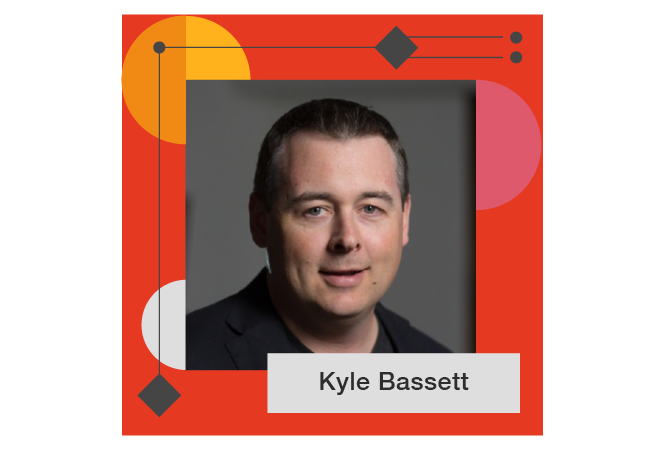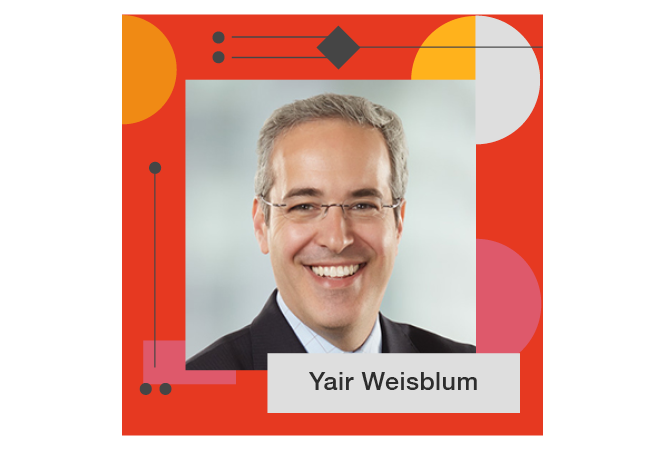
In this four-part Transformation Talks video series, PwC Canada’s Kyle Bassett and Yair Weisblum explore the importance of cloud computing in creating value for Canadian banks. Join them as they share insights from PwC Canada’s own experience and offer advice to banking executives looking to accelerate their journey to delivering even better outcomes from cloud investments.

Part 1: Realizing the potential of cloud
Cloud transformation is key to Canadian banks’ efforts to innovate and stay competitive. Watch Kyle and Yair in the first part of this video series as they discuss what cloud computing is and how it can accelerate change within Canadian banks.
Yair: Welcome to Transformation Talks, a PwC Canada series on the future of Canadian banking. My name is Yair Weisblum, a banking consulting partner at PwC Canada. Joining me today is Kyle Bassett, PwC's cloud engineering practice lead. Welcome, Kyle.
Kyle: Yeah, nice to be here.
Yair: Kyle, before we get into the details, I thought we’d take a step back and you could provide our audience a bit of a definition on what cloud means to you?
Kyle: Well, cloud, it's a big word these days, isn't it? It could mean a lot of things to a lot of different people. It used to be thought of as someone else's data center to a certain extent but I see it more as a place to run business applications today. The applications are king for our customers and people need to solve business problems and they need to take advantage of some of the forward thinking that cloud gives us.
I also think it's a great place to take a security first approach. So a security first approach would mean re-looking at how we do identity management, re-looking at how we host business applications, and we've got a lot of process and a lot of legacy thinking in the traditional data center, so cloud-first is a good way to start that. I really look at it as a place to drive change, drive innovation. And sure it's someone else's data center, but that's kind of a good thing nowadays.
Yair: Why is cloud investment so critical for Canadian banks and quite frankly for large organizations within our ecosystem?
Kyle: I think we're at the point where we can't ignore it anymore. The velocity that it brings when you look at it from a competitive advantage perspective, it's just something we got to do. There's been a lot of business cases built over the last number of years that were very strong, but it also involved getting out of data centers, letting someone run that capacity that's a little bit more efficient at it.
The other thing it's going to do for us is it's going to force us to rewire and re-look at how we bring these applications and how we release features quicker. We've got a lot of competitiveness from smaller companies coming up and competing with the big ones that we never really had before, so it's time to invest as it's not a small one, two year journey. This sometimes can take a decade to evolve and I think the world we live in now, we've figured out that it's constantly changing and you can't avoid the change that's required to be competitive, and cloud's going to give you that kind of competitive advantage.
Part 2: Embracing cloud as a strategic tool
In the second part of this video series, Kyle and Yair explore the value of investing in cloud technologies, including how they can help Canadian banks advance their capabilities in key areas like data analytics and machine learning.
Yair: What do you think are some of the sustained outcomes that banks are looking to get out of this?
Kyle: I think a lot of times in the past we tried to look at business cases as multi-year and we would find out when those years are complete whether we've returned on our investment or not. Now we're getting to the point where we need to look at things in weeks and months and we may have to pivot. We have to be okay with failure in a rapidly developing world.
In a lot of, call it back in the day, projects that I was involved in, you were so far invested in them, you could not pivot. You had to stay in and contracts were designed that way. So in today's world, we're consuming things as we need it. Even from a consulting perspective, our customers are asking us to deliver services differently. They want them delivered in teams. They don't just want the traditional send me a person that's good at this. So it's forcing us all to change, but at the end of the day, we're measuring ourselves in shorter increments and we're able to show that value.
Yair: One of the things that I'm hearing quite a lot in the bank is the usage of data in the cloud and the ability to do things that you weren't able to do before. Do you have a perspective on that?
Kyle: Everyone's heard the term data is the new oil and it's an interesting comment that makes you think about what does that really mean? What I'm seeing is we've spent a lot of time building the systems. You know the world has been in a POC with cloud for many many years. I think the year of production is coming, this year and next year. Almost all of our projects involve data analytics and then people are starting to look at machine learning. Now you obviously have to build that foundation first, if you get your data into cloud, which is great, can you use it? Can you use the numbers that matter? We're always worried about privacy and PII, which is very important, but nowadays there's tools to automate that and pipelines. And we can prove back to the businesses and regulators that it's safe.
Once it's there and structured, a whole bunch of opportunities come up. We can start to build dashboards, we can start to do analytics. And the things that are possible with machine learning today is pretty staggering. But it's hard to get started. It's a special skill set. It's new. What we've started doing is building a lot of accelerators. We're putting teams together to be very opinionated, build reference architectures and then we want to bring these to our customers and start fast, get to the business problem right away and not be building infrastructure for months.
Part 3: Accelerating innovation and digital transformation
Seeking out diverse perspectives and taking a security-first approach are vital elements of a successful cloud transformation journey. Kyle shares insights on PwC Canada’s experience and how banks can use our approach as a catalyst for value creation.
Yair: Kyle, we've been on the cloud journey ourselves at PwC. Can you tell us a little bit about that?
Kyle: Yeah. So it's pretty exciting. I joined recently, and took a little while to figure out the place of course, but I was really encouraged by how far along and how much work the firm has done to push to cloud and get people embracing it and using modern tools, in a very safe, prudent way. Taking a security first approach.
One of the things that gives us a benefit though is we get a diverse perspective. Inside the firm, we get to work as a global network and we've learned a lot together and we've been on this journey, but we get to take those experiences to our financial services clients. We get to work with clients that are at different stages of their modernization journey, different levels of maturity. We get to see both sides of that and then come in and build a purpose fit project for that type of customer. So I encourage our teams to share those stories, in the nature of where we were successful, where did we see failures? We take those learnings and we help accelerate our customers and get them fit for cloud.
Yair: And we're such a big firm at PwC, how do we ensure that our people are using those cloud tools in their everyday work?
Kyle: Yeah, it's a big place to navigate, just like our financial services customers. There's a lot of employees. There's a lot of different departments. There's a lot of silos. Some things haven't changed. You have to work with people, you have to find their motivations. This has been a multi-year journey to really get to cloud. We're one of the biggest deployments worldwide, when you look across the firm, the firm is under a lot of compliance and regulation, we should be, with the type of work we're doing, and we've been able to pull it off. We looked at cloud and security differently when we did this implementation and on this journey, which I think put us in a better place than maybe we were before. So I'm encouraged by that. I want to be able to bring those learnings to our customers and be able to help them.
Cloud's pretty complex. So having that depth of experience, I think really separates us from other firms and other options for customers. We can really bring those breadth of knowledge and get to the problem, get to the business solution and work as one team.
Part 4: Maximizing outcomes from your cloud investments
In the last part of this video series, Kyle provides advice for executives looking to the next stage of their cloud journey. From building on past successes and learning from failures to setting up a solid foundation and moving forward to production, Kyle speaks from personal experience about the key elements of success.
Yair: A cloud journey in a bank or a larger organization sounds like a huge undertaking. What advice would you give executives who are either starting their journey or in the midst and looking for changes?
Kyle: Talking to our banking customers, I think they have to look back and do some retrospectives on the last number of years. None of this change is easy. Change is hard. So when we consider our clients, they've made their bets on who their cloud service providers are going to be and now they're in many cases looking at a second. They've picked a lot of SaaS, platform as a service partners. They've been very strategic. They moved a lot of things to the cloud.
What I would say to our customers is make sure that they look at where they were successful but also where did things get tripped up? A lot of processes got put in place inside the banks with good reason. We've also learned about security and zero trust models and we've gotten better at cloud.
So there's stuff our customers can learn from that. And I think they can move faster, but they also need to look at some of that red tape that's been put in place and remove those blockers. The talent we're after today to drive some of these changes, they want to move fast. They want to accomplish something at work every day. So it's important to kind of relook at how we're doing things and pivot and work with regulators, work with our customers, give them advice, make them feel safe and push them on that journey. I think that's our job to push people along.
Yair: Well, Kyle, that was fascinating. Do you have a perspective on what the three, I guess, main key takeaways are as bank executives look to start or modify their cloud journey?
Kyle: I think we have to look back at the success that's happened over the last number of years. We've done a lot of great things. So we have to go back and do some retrospectives and say what worked well. And sometimes it's asking the people that are new, people that have been there a little, getting a diverse perspective is a really big one. But there's other areas that haven't gone so well or we put too much red tape around and it's causing us to move slower. We have to look at what's slowing us down. If it's regulations, if it's too much process, let's automate those type of things.
All that comes from building a solid foundation. It's something people say all the time, but getting that foundation right, gets you to build those second, third, fourth floors. And I think there's ways to look around, talk to your peers, look at projects, look at the industry and build from that. There's a lot of great reference architectures. We're not reinventing the wheel anymore.
And then if anything, we got to get to production in the next couple years. There's been a mountain of dev tests done. We've learned a lot, but we really need a push to production. Get rid of the data centers, retire some of the old applications, modernize. We're going to not really realize that business case if we have the old data center and the old systems around. So we really got to get to production.
Yair: Well, thanks, Kyle. That was awesome. We're super excited about the opportunities for cloud in Canadian banking.
Kyle: Let's keep learning and doing great things.
"I really look at cloud as a place to drive change, drive innovation."
About the speakers

Kyle Bassett is a Partner and Cloud Practice Lead at PwC Canada. He has been working with cloud and other transformational technology solutions throughout his career in industries including financial services. He has also been a key member of several cloud-focused start-ups.

Yair Weisblum is a Partner in PwC Canada’s financial services consulting and deals practice. He brings more than 15 years of experience, working with a variety of organizations on issues including digital strategy, information management, commercial and retail banking and process design.
Related content


Case study: Cloud security transformation
A major North American bank builds up cloud security governance, cloud data security and architecture capabilities to fast-track its cloud adoption ambitions.

Reaching your full cloud potential
The cloud is not a tactic; it is a strategic tool. In this article, PwC experts outline seven mission-critical factors for changing your approach.
Transformation Talks Series

Transformation Talks: Sustainable finance in banking
Three actions to build trust and harness sustainable finance as a tool to transform Canadian banks on the path to net-zero greenhouse gas emissions.

Enhancing customer experience in wealth management
Why now is the time to invest in technology that delivers meaningful insights and build a learning culture that leads to better client outcomes.

Taking a people-centred approach to maximize human potential at a time of relentless change
Now is the time for Canadian banks to refresh their workforce strategies by cultivating a growth mindset that empowers employees and the organization.

How Canadian banks can harness the data analytics opportunity in 2023
What do generative AI and other tech innovations mean for the future of Canadian banks?
Contact us

Banking and Capital Markets, Lead Relationship Partner, PwC Canada
Tel: +1 416 941 8311






















